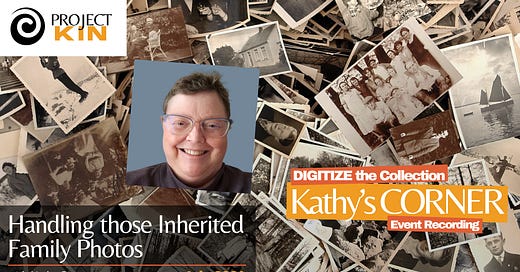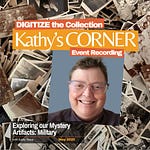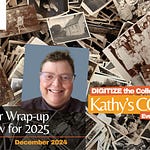Old photos, documents, and other digital files and artifacts are often at the emotional center of our family history archives. Many of us consider our role as guardians of these materials even as we set about using them to share family stories.
Unfortunately, if we “use” these photos without a system, we risk modifying our originals or creating a printing press of duplicates.
This program is free and scheduled for the 4th Thursday of each month. To see upcoming programs, please visit our Events page:
Using photos in projects
In today’s episode, Projectkin’s
dives into this challenge with a professional's confidence and a neighbor's practicality. Discussion covers topics like:After you’ve scanned an original print, is it ever okay to modify the original scan you’ve added to an archive? Well, it depends. A good rule of thumb is that if the change is non-destructive, that’s fine. If it’s destructive, maybe not. Examples include:
Rotation: It’s non-destructive, that’s fine
Crop: Since it is destructive and you can’t go back, it is probably not a good idea. Make a copy of the original and crop away.
Colorizing: It is also destructive in that you can’t go back, probably not a good idea. A better idea is to make a copy, then colorize.
Repairs: It depends. Consider the example of faded image color from the 1970s. You could modify the color today, but it’s destructive. Once you modify the file, you can’t go back to the original.
Are catalog-based apps that modify files by mapping to their physical location on a drive a good idea? Lightroom and ACDSee are examples. They can be useful, but they can also be very confusing if you don’t understand what changes they’re making.
We discussed using the physical location of files at length. Kathy shared a whiteboard illustrating the idea of an archival photo hub, family archive, or “central place” to store photos. See time-stamp 21:56.
Our resident Photogenealogy expert,
, participated in today’s call, making several terrific suggestions, including:Adding simple text-based “Read Me” files to folders can be useful when you add images to special-purpose folders. Project folders are examples.
Resources
During today’s program,
referenced articles Caroline Guntur of OrganizingPhotos.net has used in her programs that can be helpful as well:What’s the Difference? Digital Files vs. Digital Assets
Edits and Versions Worksheet from Caroline Guntur of OrganizingPhotos.net
Also notable: How to Create a Photo Hub by Amanda Littlecott
Summary
Managing your way between an archive and project files requires a clear articulation of three things:
A clear understanding of what is acting as your main archive.
That you keep originals “intact” — duplicates will happen, but your workflow should ensure that you’re not making them unnecessarily.
Your “Project-based organizing” workflow should…
Never remove originals from the archive,
Always ensure that work in progress is backed up
Allow for the final product to be archived. Depending on the nature of the project, you may also want to archive the tools, modified files, and artifacts used in producing it.
After today’s program, this recording, like all Projectkin program recordings, was emailed to all members. Learn more about how Projectkin works here.1
Please visit Projectkin.org/about


















Share this post